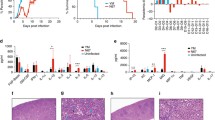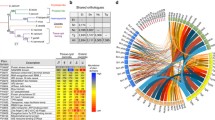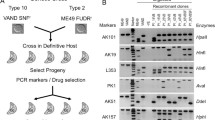Abstract
There are large differences in virulence among the various strains and isolates of T. gondii, although only one species of the genus Toxoplasma has been observed to exist so far. This virulence diversity among isolates may have considerable impact on epidemiology, immunology, pathology and the parasite-host relationship. Evidence that there is more than one strain of T. gondii is based on the observation of differences in virulence among different isolates for laboratory animals (Krahenbuhl and Remington 1982). Virulence can be estimated as either the time taken before infected animals die and the percentage of mortality, or the number of parasites needed to kill infected animals (Kaufman et al. 1959; Dubey and Frenkel 1973). Some strains such as the extremely virulent RH strain have lost the ability to form oocysts in the cat, and as few as ten tachyzoites can be lethal for a mouse within a week when injected i.p. Other strains such as the avirulent S-1 strain form cysts in the brains of mice injected with 1000 oocysts (equivalent to 8000 tachyzoites) and these mice survive without ill effects (Dubey and Frenkel 1973). Early studies showed that differences in virulence correlated with tachyzoite generation time in tissue culture (Kaufman 1958; Kaufman et al. 1959). Virulent strains rapidly destroy the cells while avirulent strains grow slowly causing minimal cell damage. The pathogenicity of some avirulent strains has been observed to increase following frequent i.p. passage of the tachyzoites in mice (Frenkel 1956).
Access this chapter
Tax calculation will be finalised at checkout
Purchases are for personal use only
Preview
Unable to display preview. Download preview PDF.
Similar content being viewed by others
References
Asai T, Miura S, Sibley LD, Okabayashi H, Takeuchi T (1995) Biochemical and molecular characterization of nucleoside triphosphate hydrolase isozymes from the parasitic protozoan Toxoplasma gondii. J Bioi Chem 270:11391–11397
Cristina N, Liaud M, Santoro F, Oury B, Ambroise-Thomas P (1991a) A family of repeated DNA sequences in Toxoplasma gondii: cloning. sequence analysis, and use in strain characterisation. Exp Parasitol 73:73–81
Cristina N, Oury B, Ambroise-Thomas P, Santoro F (1991b) Restriction fragment length polymorphisms among Toxoplasma gondii strains. Parasitol Res 77:266–268
Cristina N, Dardé ML, Boudin C, Tavernier G, Pestre-Alexandre M, Ambroise-Thomas P (1995) A DNA fingerprinting method for individual characterisation of Toxoplasma gondii strains: combination with isoenzymatic characters for determination of linkage groups. Parasitol Res 81:32–37
Dubey JP, Frenkel JK (1973) Experimental Toxoplasma infection in mice with strains producing oocysts. J Parasitol 59:505–512
Frenkel JK (1956) Pathogenesis of toxoplasmosis and of infections with organisms resembling Toxoplasma. Ann N Y Acad Sci 64:215–251
Granstrom DE, MacPherson JM, Gajadhar AA, Dubey JP, Tramontin R, and Stamper S (1994) Differentiation of Sarcocystis neurona from eight related coccidia by random amplified polymorphic DNA assay. Mol Cell Probes 8:353–356
Guo Z-G, Johnson AM (1995a) Genetic characterization of Toxoplasma gondii strains by random amplified polymorphic DNA polymerase chain reaction. Parasitology 111: 127–132
Guo Z-G, Johnson AM (1995b) Genetic comparison of Neospora caninum with Toxoplasma and Sarcocystis by random amplified polymorphic DNA-polymerase chain reaction. Parasitol Res 81:365–370
Innis MA, Gelfand DH, Sninsky JJ, White TJ (1990) In: White TJ (ed) PCR protocols: a guide to methods and applications. Academic, San Diego, pp 482
Jacobs L (1972) New knowledge of Toxoplasma and toxoplasmosis. Adv Parasitol 11:631–669
Joachim A, Tenter AM, Jeffries AC, Johnson AM (1996) A RAPD-PCR derived marker can differentiate between pathogenic and non-pathogenic Sarcocystis species of sheep. Mol Cell Probes (in press)
Johnson AM (1984) Strain-dependent. route of challenge-dependent. murine susceptibility to toxoplasmosis. Z Parasitenkd 70:303–309
Johnson AM (1990) Toxoplasma: biology, pathology, immunology and treatment. In: Long PL (ed) Coccidiosis of man and domestic animals. CRC, Boca Raton, pp 121–153
Johnson AM (1989) Toxoplasma vaccines. In: Wright IG (ed) Veterinary protozoan and hemoparasite vaccines. CRC, Boca Raton, pp 177–202
Kasper LH, Boothroyd JC (1993) Toxoplasma gondii: immunology and molecular biology. In: Warren K (ed) Immunology and molecular biology of parasitic infections. Blackwell, London, pp 269–299
Kaufman HE (1958) Toxoplasmosis: the nature of virulence. Am J Ophthalmol 46:255–260
Kaufman HE, Melton ML, Remington JS, Jacobs L (1959) Strain differences of Toxoplasma gondii. J Parasitol 45: 189–190
Krahenbuhl JL, Remington JS (1982) The immunology of Toxoplasma and toxoplasmosis. In: Cohen S, Warren KS (eds) Immunology of parasitic infections. Blackwell, London, pp 356–421
Luton K, Gleeson M, Johnson AM (1995) rRNA gene sequence heterogeneity among Toxoplasma gondii strains. Parasitol Res 81:310–315
Mackenstedt U, Johnson AM (1995) Genetic differentiation of pathogenic and nonpathogenic strains of Entamoeba histolytica by random amplified polymorphic DNA polymerase chain reaction. Parasitol Res 81:217–221
MacPherson JM, Gajadhar AA (1994) Specific amplification of Sarcocystis cruzi DNA using a randomly primed polymerase chain reaction assay. Vet Parasitol 55:267–277
Martin GB, Williams JGK, Tanksley SD (1991) Rapid identification of markers linked to a Pseudomonas resistance gene in tomato by using random primers and near-isogenic lines. Proc Natl Acad Sci 88:2336–2340
McLeod R, Estes GR, Mack DG, Cohen H (1984) Immune response of mice to ingested Toxoplasma gondii: A model of Toxoplasma infection acquired by ingestion. J Infect Dis 149:234–244
Parmley SF, Gross U, Sucharczuk A, Windeck T, Sgarlato GD, Remington JS (1994) Two alleles of the gene encoding surface antigen P22 in 25 strains of Toxoplasma gondii. J Parasitol 80:293–301
Rinder H, Thomschke A, Dardé ML, Löscher T (1995) Specific DNA polymorphisms discriminate between virulence and non-virulence to mice in nine Toxoplasma gondii strains. Mol Biochem Parasitol. 69: 123–126
Sibley LD, Boothroyd JC (1992) Virulent strains of Toxoplasma gondii comprise a single clonal lineage. Nature 35:982–85
Stevens JR, Tibayrenc M (1995) Detection of linkage of disequilibrium in Trypanosoma brucei isolated from tsetse flies and characterised by RAPD analysis and isoenzymes. Parasitology 110:181–186
Welsh J, McClelland M (1990) Fingerprinting genomes using PCR with arbitrary primers. Nucleic Acids Res 18:7213–7218
Welsh J, Petersen C, McClelland M (1991) Polymorphisms generated by arbitrary primed PCR in the mouse: application to strain identification and genetic map**. Nucleic Acids Res 19:303–306
Williams JGK, Hanafey MK, Rafalski JA, Tingey SV (1993) Genetic analysis using random amplified polymorphic DNA markers. Meth Enzymol 218:704–740
Williams JGK, Kubelik AR, Livak KJ, Rafalski JA, Tingey SV (1990) DNA polymorphisms amplified by arbitrary primers are useful as genetic markers. Nucleic Acids Res 18:6531–6535
Author information
Authors and Affiliations
Editor information
Editors and Affiliations
Rights and permissions
Copyright information
© 1996 Springer-Verlag Berlin Heidelberg
About this chapter
Cite this chapter
Guo, ZG., Johnson, A.M. (1996). DNA Polymorphisms Associated with Murine Virulence of Toxoplasma gondii Identified by RAPD-PCR. In: Gross, U. (eds) Toxoplasma gondii. Current Topics in Microbiology and Immunology, vol 219. Springer, Berlin, Heidelberg. https://doi.org/10.1007/978-3-642-51014-4_2
Download citation
DOI: https://doi.org/10.1007/978-3-642-51014-4_2
Publisher Name: Springer, Berlin, Heidelberg
Print ISBN: 978-3-642-51016-8
Online ISBN: 978-3-642-51014-4
eBook Packages: Springer Book Archive




